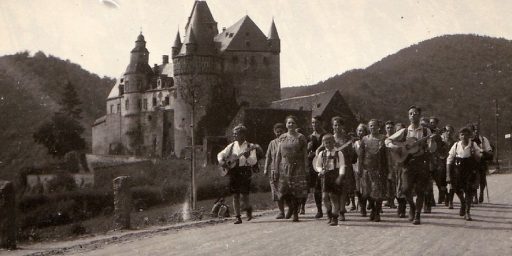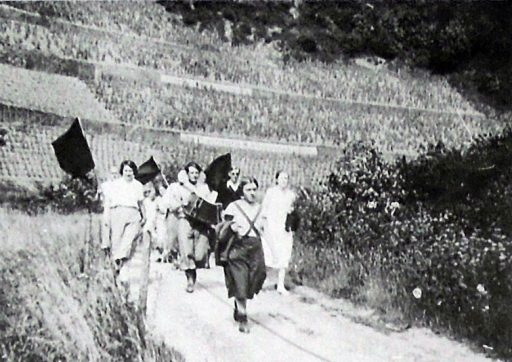During the 1930s the German Nazi Party banned several political parties and organizations whose ideals were opposing the National Socialism preached by Hitler and his subordinates. From 1933 to 1945, many Naturefriends left Germany and Austria, while many others decided to fight back the Nazi regime, although with no avail. Several Naturefriends would end up in prison and were executed. In this second article about the history of the Naturefriends movement, Max Menkenhagen explains the ban, the struggles and the resistance of the Naturefriends, during the biggest tragedy of the 20th century.
By Max Menkenhagen
1933 – 1945: The break-up of the Naturefriends in Europe
The Second World War ended the first heyday phase of the TVdN. Yet, already before Hitler and his henchmen unleashed the biggest catastrophe of the 20th century, worrisome developments began to unfold. In the 1930s the atmosphere on the streets of Europe is tense, especially in the German speaking part of the continent. The golden 20s are over, the financial crisis in the USA sweeps over to the streets of Europe, fueling the political tensions between left and right, ultimately provoking bloody clashes between the red workers’ front, a loose and fragile coalition between communists and social democrats, and the brown goon squads of the NSDAP, the party of the fascist national socialists led by Hitler. This intense political situation impacts the TVdN in Germany and eventually even beyond.

A group of Naturefriends walking near Maria Laach Abbey, Germany (1925) Foto: Repro GA
The influence of these camps, and political parties in general, is an issue discussed widely within the TVdN in the mid-20s. Special attention is given to the influence of the German Communist Party on the TVdN, and especially on its youth segments. The concerns about party affiliation of the segments two main reasons: On the one hand, too much influence of political parties is perceived as incision into the free development of the organization and the individuals in it, which would ultimately divide the young Naturefriends along party lines. On the other hand, as the fascist takeover becomes foreseeable, the TVdN tries to distance itself from the communist party in order to not fall into the ‘banning grid’ of the new regime. As a consequence, in 1924 a special conference aims to settle the dispute by adopting a resolution, stating that the connection to, or open coalition between TVdN segments and party affiliated organizations is prohibited, and noncompliance would result in exclusion. Until 1932 this approach leads to the exclusion of 213 chapters (comprising around one third of all German members!) (in: Hoffmann & Zimmer, 1986, pp. 33). Yet, the TVdN does not completely distance itself from the party spectrum, stating that it supports a large share of the demands of the communist and social democratic party, and that their members would still be welcome in the TVdN as long as they distinguish between interests and policy of the party and the TVdN. Retrospectively, the TVdN is right to declare that “the purpose of this manoevre was as transparent as it was illusionary: In complete misjudgment of the totalitarian [German] state that would not differentiate between any Marxist organizations, the German TVdN tried to save itself by distancing from the communists” (In: Hoffmann & Zimmer, 1986, p. 34). After all, even this desperate attempt proved to not be successful.

Black flags as a sign of mourning and protest against the ban of all “Naturefriendly” activities by the Nazi Party, Heepen, Germany (1933) Foto: NFI archives
It takes less than half a year for the regime to forbid all political parties and organizations except the NSDAP. Marxist organizations enjoy special attention from the regime after a Communist conspiracy was blamed for burning down the Reichstag – and the TVdN is seen as such. With the prohibition more than 400 Naturefriends houses are confiscated, of which almost 300 are located in Germany.
In Austria the clerical-fascist regime forbid all social-democratic organizations after the 12th of February 1934. Yet, the Naturefriends did not seize to exist – at least in illegally-adjusted and heavily restricted form – until the German invasion in March 1938. Not only an illegal central administration continued to exist, but also subject-specific working groups; some continued their political education, while others worked in semi-legally camouflage activities for the resistance. This variety of tasks led to an intricate interlacing of the Naturefriends with illegal organizations, e.g. in the case of the Vienna Naturefriends organization of tramway employees (For more information, see Eduard Rabofsky: Die Naturfreunde im Widerstand. In: Naturfreunde Österreich (Hg): Naturfreunde und Arbeiterbewegung. Seminarbericht Wien 1984). As a matter of prudence, the central committee of the TVdN Austria started to transfer shares of the membership fees to Zurich, Switzerland, already in 1932. In 1933, the organization secures the remaining Austrian cash assets in case the Austrian Naturefriends are closed down. After the Dollfuß government dissolves the Austrian Naturefriends in 1934 this plan worked out and the Austrian TVdN assets could safely be transferred to the Swiss neighbors, along with a change in main offices to Zurich.
After the German annexation, Austria and Czechoslovakia suffer the same destiny as the Germans did earlier: confiscations, arrests, harsh penalties. This induced Austrian authorities to quit the semi-legal work. Yet, numerous Naturefriends groups – especially in the alpine border region to Switzerland – remained active in the resistance, disguising their assemblies as excursions in the ‘Naturefriends-style’. This maintenance of semi-legal structures and the work in the resistance movement would later ease the reconstruction of the official Naturefriends network after 1945.
After the early successes of the Wehrmacht carry the Naturefriend ban to the whole of Europe, the organization that once claimed to be global in its scope has only two intact national organizations left, one in the United States of America and one in Switzerland. Here, the organization is growing steadily. The reason for this was mainly the broad cultural work and the concrete focus on youth work as well as “Volkstourismus” (folk tourism), a focus that would define the Swiss Naturefriends work for some time to come. Public relations of the Swiss movement are comparatively intense at this point. Next to the international magazine “Naturfreund”, the Swiss TVdN publishes the Swiss “Berg Frei” with a French and Italian attachment, then from 1940 onwards the “L’Ami de la Nature”. In the same year the medium film is used for the first time with the movie “Berg-Frei”, used especially in the Swiss Army. Based on the “Workers Illustrated Newspaper” (Arbeiter-Illustrierte-Zeitung AIZ) of the Weimar Republic, former AIZ editor and one of the most active Swiss Naturefriends Theo Pinkus creates the “Naturefriends-Illustrated” (Naturfreunde-Illustrierte), to be published twice a year. Due to its modern makeup and the journalistic style of writing this magazine reaches a circulating number of 20,000.
Regardless of these successes, the situation is desperate. Disillusioned, the annual report of the central committee for 1940 states: “Fruitful work could not have been done; instead, actions focused on preserving the remaining foundation for a better future. With this intention, the two national administrations of Switzerland and America supported the central committee as good as they could” (Zimmer, 1993, p. 18).

Image 3:Depicting the spirit of the times: In an iced up heart the three mountain flowers depicting the Naturefriends logo. Underneath: “Trotz all der bittren Zeiten Schmerzen, blühn uns drei Blümlein tief im Herzen“ (Regardless of the pains of these times, three flowers blossom deep in our hearts) (in: Lampasiak, Gruber, Pils, 2009, p. 51).
Naturefriends in the Resistence:
It is an undisputed fact that members of the Naturefriends network participated in the (un)organized resistance against the German regime. Yet, details are hard to find in the aftermath, and it is important to note that in most cases, Naturefriends that risked their life in the fight against fascism were organizing their actions primarily within other interpersonal networks than the TVdN, i.e. their (now forbidden) party or union. In other cases, like the one of the ‘red mountaineers’ from Saxony – who would smuggle resistance fighter, prints and other equipment across borders, create connections to imprisoned TVdN members, and even plant antifascist watchwords and flags on mountains as well as weapon factories – the group was previously excluded from the TVdN due to its communist convictions. For this reason, it is false to claim that the Naturefriends were an organization in the resistance. Instead it were single members, or in rare cases single segments of the TVdN that were active in the resistance. Swiss Young Naturefriends were part of this group. While their focus initially lied on supporting the ‘Centrale Sanitaire Suisse’ and its humanitarian and medicinal help for partisan troops in Northern Italy, France and Yugoslavia, they focus more on actual youth policies towards the end of the war. This way, the Swiss NFJ turned into a hinge between the different streams of leftists, giving social democratic and communist youth groups a medium for displaying, expressing and discussing their ideas in its newspaper ‘Junge Garde’ (young guard).
All of the Naturefriends active in the resistance risked a lot. Openly being Naturefriend, or being involved in their actions, was a reason for the death penalty during Hitler’s reign, and there are plenty of examples for Naturefriends who lost their lifes in Gestapo prisons or concentration camps. A striking remnant of this dark chapter of the Naturefriends’ history is this inscription that German Naturefriend Gottfried Wiedemann found carved into his prison wall:
“Und sperrt ihr in Zuchthaus und Mauern uns ein, “And if you imprison us in the jail behind walls,
Glaubt ihr, ihr zwingt uns damit nieder? Do you think this will force us down?
Fast sieht es so aus, es hat auch den Schein, It almost looks like it, it seems to be true,
Doch glaubt mir, einst kehren wir wieder! But believe me, once we will recur!
Berg Frei” Berg Frei”
(Lampasiak, Gruber, Pils, 2009, p. 51)
We do not know what happened to whomever engraved these words into the wall, but (s)he would end up being right: the Naturefriends recurred!
